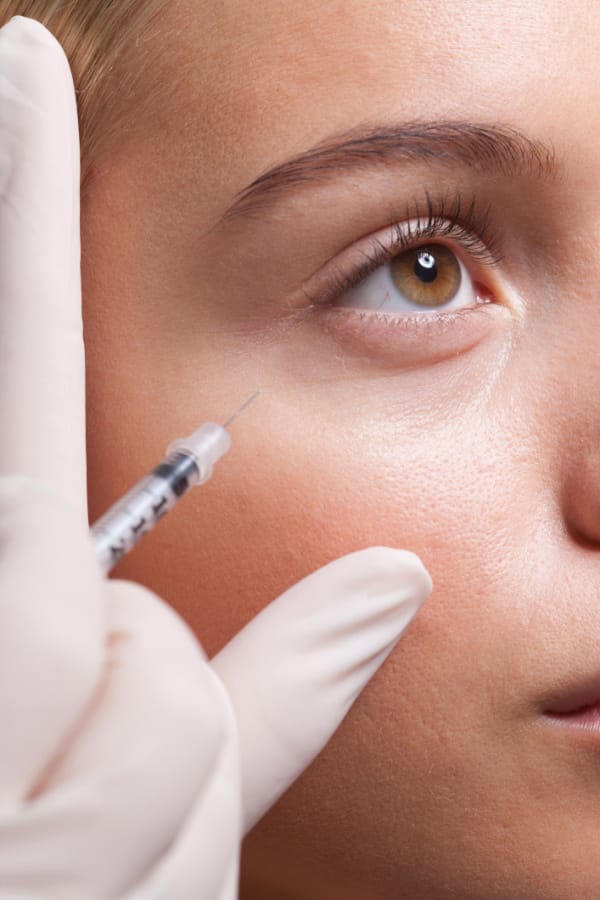How to Avoid the Tyndall Effect and Get Beautiful Under-Eye Filler Results

Dermal fillers are quickly becoming one of the most popular ways to correct under-eye bags due to their ability to smooth and “fill in” thinning skin without surgery. Unfortunately, this caused an uptick in under-qualified medical providers advertising under-eye filler injections. As a result, more patients have been sharing their experiences with one of the most common side effects associated with poor under-eye filler technique—the Tyndall effect. In this month’s post, we explain everything you need to know about the Tyndall effect, and how you can avoid it to achieve beautiful under-eye filler results.
What is the Tyndall effect?
The Tyndall effect is a rare phenomenon in which a patient’s skin takes on a bluish tone after he or she receives dermal fillers. This discoloration is most often visible in the skin below the eyes due to the area’s thin skin. Patients who experience the Tyndall effect may also have visible swelling in their under-eye skin.
The Tyndall effect is when a patient’s skin takes on a bluish tone after he or she receives dermal fillers.
What causes the Tyndall effect?
There are a few factors that can cause the Tyndall effect after filler:
- Filler is injected too close to the skin’s surface
- Filler is injected in too large of a dose
- Incorrect filler is used
The Tyndall effect may be visible immediately after treatment, or it may take a few days to appear. If left uncorrected, it may persist for months or even years.
The science behind the Tyndall effect
How is filler able to mimic the appearance of bruising below the eyes? For this, we need to delve into the science behind the Tyndall effect:
Since blue light has a shorter wavelength and a higher frequency than red light, it “scatters” roughly 10 times more than red light when it passes through small particles. Therefore, because most fillers are made of very tiny particles, the skin can take on a bluish color after filler is injected due to the way light reflects off the filler’s particles. The Tyndall effect is also the reason that the sky appears blue. (It is actually colorless!)


How can I avoid the Tyndall effect?
Some fillers have more particulates than others and are, therefore, more likely to cause the Tyndall effect. Hyaluronic acid (HA) fillers are the most common type of filler used in the under-eye area since they are smooth, transparent, and less likely to clump; however, because they are clear and made of fine particles, they are also the most likely to cause the Tyndall effect.
Non-HA fillers, like those made of poly-L-lactic acid and calcium hydroxylapatite, are not typically used in the under-eye region since they cannot be easily reversed if they provide an unsatisfactory result (more about filler reversal below).
If you wish to rejuvenate the area around your eyes without eyelid surgery and avoid the Tyndall effect, there are two methods we recommend: RHA fillers and fat transfer.
RHA fillers
Currently, the only type of dermal filler that has no risk of causing the Tyndall effect is Revance’s collection of RHA® fillers.
Currently, the only type of filler that has no risk of causing the Tyndall effect is Revance’s collection of RHA fillers.
RHA fillers, short for Resilient Hyaluronic Acid fillers, undergo a gentler manufacturing process than traditional HA fillers, creating a long-chain molecular formula that more closely resembles the natural HA found in the body compared to other hyaluronic acid fillers. As the name suggests, RHA fillers are more resilient, and, therefore, integrate into skin more naturally and last longer once injected (up to 15 months). RHA fillers are also the only filler FDA-approved for treating any dynamic lines and wrinkles—those caused by facial movements, like smiling and laughing.
Fat transfer
Fat transfer, also called fat grafting, is the only way to fill in the under-eye area without fillers. Fat transfer borrows fat from areas of the body that contain a little extra, like the hips, thighs, and stomach, and moves it to areas that could benefit from some added volume, like the under-eyes. When this surgical procedure is performed by a skilled plastic surgeon, fat transfer can rejuvenate hollowed-out under-eyes for years, as long as a stable weight is maintained.
How can I achieve the best under-eye filler results?
Achieving beautiful under-eye rejuvenation using fillers is not easy, as the skin around the eyes is very thin, and there is no fat between the skin and muscle to inject the filler into. Instead, an injector must strategically place filler into the fat below the layers of skin and muscle in the tear troughs. He or she should only inject small amounts of filler to avoid filler migration and the development of lumps and bumps beneath the eyes.
Avoid the Tyndall effect by choosing a board certified plastic surgeon with experience injecting around the eyes. Also, be sure to ask whether or not you are a good candidate for RHA fillers.


What if I am unhappy with my filler results?
If you have experienced poor filler results from an under-qualified injector, rest assured that all HA and RHA fillers can easily be dissolved using an enzyme called hyaluronidase. Hyaluronidase typically erases the appearance of fillers within 24 hours, although occasionally a second treatment may be required. If you are looking to correct your under-eye fillers, our expert aesthetics team will be happy to dissolve your old filler and re-treat your under-eyes.
Choose Kalos Medical Spa for your Fort Worth filler injections
Board Certified Plastic Surgeon Dr. Emily J. Kirby and her skilled Fort Worth med spa team have extensive experience performing cosmetic injections in the Fort Worth area. If you are interested in under-eye fillers or any of our other aesthetic treatments, contact us online or call (817) 292-4200.



J
What color product can I use over the discolored area that may counteract the Tyndall effect?
Kalos Medical Spa
Hi J, thank you for your comment. To counteract blue or grey tones in the skin that appear as a result of the Tyndall effect, you would typically use a color-correcting product with a peach or orange tint. These warmer hues are opposite blue and grey on the color wheel, and when applied, they can effectively neutralize these cooler tones. The specific shade (lighter peach for lighter skin tones, deeper orange for darker skin tones) should be chosen based on your individual skin tone for the best results. We hope you find this helpful!
Samari
Solo quiero comentar que tienen buena información en este texto y que seguramente son excelentes profesionales. !
Kalos Medical Spa
¡Muchas gracias por tu amable comentario!
Omer
Can you please tell me which under eye cream is better to use for Tyndall effect. After under eye brightening injection my under eyes now looks like ash color. Your earlier response is highly appreciated.
Kalos Medical Spa
Hi Omer, For the Tyndall effect after under-eye filler injections, it’s important to focus on eye creams that are designed to maintain general skin health. We recommend you look for eye creams with hydrating and soothing ingredients like hyaluronic acid, ceramides, and peptides. However, if the discoloration is significant, it’s best to consult with your injector or a qualified plastic surgeon for potential treatments, such as dissolving the filler or other corrective measures. If you live in the Fort Worth area or are willing to travel, we would love to see you! Please give us a call or submit a contact form online to schedule a consultation. Thank you!